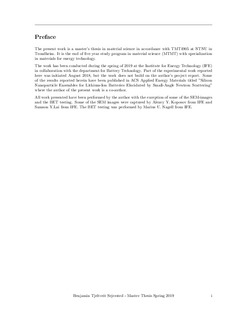| dc.contributor.advisor | Wiik, Kjell | |
| dc.contributor.advisor | Koposov, Alexey Y. | |
| dc.contributor.advisor | Lai, Samson Y. | |
| dc.contributor.author | Sejersted, Benjamin T. | |
| dc.date.accessioned | 2019-10-19T14:02:36Z | |
| dc.date.available | 2019-10-19T14:02:36Z | |
| dc.date.issued | 2019 | |
| dc.identifier.uri | http://hdl.handle.net/11250/2623370 | |
| dc.description.abstract | Silicon has shown large promise as an alternative to graphite anodes in lithium-ion batteries. The theoretical specific energy capacity of silicon is almost an order of magnitude larger, and silicon is vastly abundant and produced at large scales. The problem is that the specific energy capacity rapidly fades during cycling especially at high charging or discharge rates. This problem is due to a large volume increase during cycling and the low conductivity of silicon.
In the present work two methods for mitigating these issues are investigated: ball milling and carbon coating. The ball milling behavior of different types of silicon was investigated during ball milling in air. After ball milling the treated silicon was investigated using BET analysis and cells were created to compare cyclability and specific energy capacity across silicon types. A carbon coating method adapted from Meng et al. and Lu et al. were implemented using phenol as a monomer. It was attempted on pristine and ball milled particles. The ratio of Si:polymer was varied in an attempt to identify an optimal monomer amount. The particles were investigated using SEM and STEM imaging and cells were created for cycling and rate testing.
The ball milling investigation indicated that the ball milling behavior of silicon is highly dependent on the specific properties of the silicon type. Ball milling of amorphous silicon likely causes the formation large amounts of silicon oxide which are detrimental to battery performance. Silicon particles were partially covered in carbon which adhered to the surface, but clear confirmation of a complete coating were not found. | |
| dc.description.abstract | Silicon has shown large promise as an alternative to graphite anodes in lithium-ion batteries. The theoretical specific energy capacity of silicon is almost an order of magnitude larger, and silicon is vastly abundant and produced at large scales. The problem is that the specific energy capacity rapidly fades during cycling especially at high charging or discharge rates. This problem is due to a large volume increase during cycling and the low conductivity of silicon.
In the present work two methods for mitigating these issues are investigated: ball milling and carbon coating. The ball milling behavior of different types of silicon was investigated during ball milling in air. After ball milling the treated silicon was investigated using BET analysis and cells were created to compare cyclability and specific energy capacity across silicon types. A carbon coating method adapted from Menget al. and Lu et al. were implemented using phenol as a monomer. It was attempted on pristine and ball milled particles. The ratio of Si:polymer was varied in an attempt to identify an optimal monomer amount. The particles were investigated using SEM and STEM imaging and cells were created for cycling and rate testing.
The ball milling investigation indicated that the ball milling behavior of silicon is highly dependent on the specific properties of the silicon type. Ball milling of amorphous silicon likely causes the formation large amounts of silicon oxide which are detrimental to battery performance. Silicon particles were partially covered in carbon which adhered to the surface, but clear confirmation of a complete coating were not found. | |
| dc.language | eng | |
| dc.publisher | NTNU | |
| dc.title | Investigating Methods for Improving the Perforamce of Si in LIBs: Ball Milling in Air and Carbon Coating with Phenolic Resin | |
| dc.type | Master thesis | |
